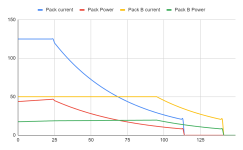The tapering is not a "safety" thing (well, not directly). It's just simple electricity/chemistry.
Charging a battery takes place in two stages. In the first stage, current is "pumped" into the battery at a constant rate. This is called the constant current (CC) phase. The vehicle calls for a certain amount of current that the battery engineers have determined the battery can handle (possibly based on the battery temperature--cold batteries should not be charged really fast, or even at all in the case of REALLY cold temps--they would need to be warmed up first). The charging station complies to the best of its ability. As the battery "fills", the voltage rises slowly, and because power = current * voltage, and current is constant while voltage rises slightly, you will actually see a slight power INCREASE during this time.
Then, when the state of charge reaches a certain point, again, determined by the battery engineer that designed the battery, the BMS switches over to constant voltage (CV) charging. Now instead of "pumping" in a set amount of current, the vehicle calls for a set voltage, slightly above the battery's fully charged voltage. This allows current to flow into the battery akin to the usual Ohm's law behavior (although the resistance is not inherent to the battery material itself, but rather the chemical nature of the ion transfer process inside the battery, but nonetheless, it works the same.
Ohm's law specifies V = I * R
V is the voltage differential between the charging station voltage and the current battery voltage (which again, rises slowly as the battery charges, so as this happens, V is getting smaller. I is the amount of current flowing into the battery, and R is the internal resistance of the battery. It's helpful if we re-arrange this equation to:
I = V / R
As V gets smaller (because the battery is filling up and the voltage differential is dropping) and R is getting larger (because it's getting harder to pack more ions into the anode), the amount of current flowing into the battery drops, and as a result, power (which again, is P = I * V) drops as well (in this equation, V is the pack voltage, which IS still increasing slightly, but not as fast as I is dropping).
So as you can see, the taper off (which starts immediately as the vehicle calls for a switch from CC to CV) is not being actively controlled by the vehicle, but rather by physics (or chemistry).
An analogy that I think works pretty well is to think of the battery as a container of water and the charging station as a hose. At first you just turn on the hose and actively pump a fixed flow of water into the container. But as the container gets close to full, you stop actually pumping water into the hose, and instead let one end of the hose float on top of the water in the container, and you raise the other end of the hose (which is contained to another basin of water) above the level of the container. Gravity will do its job and water will continue to flow fairly quickly down the hose. But as the level of water in the container rises, the slope of the hose gets less and less, and eventually there is not much slope at all, and the water only trickles into the container.
So that is the stock answer to your question. Hopefully that helps explain what is going on.
However, it's not entirely accurate!
New charging techniques are coming out (Hyundai/Kia employ this kind of strategy) where the current in the CC phase is dynamically stepped down throughout the charging process to more dynamically control the charging process. So for example, instead of shifting immediately to CV from CC, it may step down the CC current in stages until eventually shifting to CV. Here is the Kia EV6 charge curve for example:
You can see the slight increase in power while in CC mode from 0 to 52% (due to the battery voltage slightly increasing during this time). Then at 52% you can see a dramatic drop in power (caused by a step down of the CC current) and again from 52% to 62% we see a slight increase in power. The same step down appears at 62% and 68%, and then finally at 77% it switches over completely to CV and we see the more dramatic taper characteristic of CV phase. In a more traditional CC/CV we would see the shift to CC to CV happen earlier, and then a shallower CV slope.


